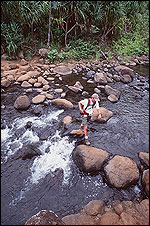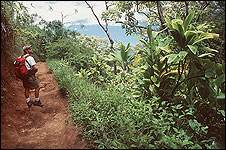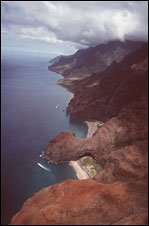
learn
Na Pali Coast: A walk on Kauai's wild side
By Dave Wortman.
A deeply tanned, golden-haired boy stood perched barefoot on a streamside boulder, wearing nothing but a tattered orange sarong. "Hello, my name is Kee," he proclaimed with an almost angelic expression and welcoming gesture. "Welcome to Kalalau."
Down on the beach, bulging sacks of mango and guava freshly plucked from the forest swung lazily in the afternoon breeze from the branches of kukui trees.
As we lumbered along the sand with our gear-heavy packs, we passed a small group of our more scantily clothed neighbors -- they nodded and smiled, yet at the same time seemed to take us in with an eye of suspicion.
Behind us, spirelike peaks lushly draped with brilliant green vegetation soared upward into swirling mist. We felt awestruck and yet oddly out of place.
Voyaging deep into the backwoods of Hawaii, our destination was the famed Kalalau Valley and beach along Kauai's Na Pali Coast. Here, mountain landscape meets the turquoise Pacific to form a surreal and striking backdrop, drawing a quirky smattering of visitors, from backpackers to more permanent "residents" looking to drop out of life for a while.
Once you've witnessed the place, it's easy to understand why Kauai has been the setting for a long list of movies such as "King Kong" and "Raiders of the Lost Ark." I made the winter-season trek with a longtime hiking friend, searching for the solitude that descends on one of the Pacific's most remote beaches this time of year.
On the trail
Staring out from the trailhead at the edge of a seemingly endless series of cliffs rippling from the coast off into the distance, our excitement was dampened with a degree of apprehension.
I'd heard stories of the rugged terrain, precipitous cliffs and legendary red mud that inevitably coats hikers from head to toe along the nearly 11 miles of trail. One friend, marooned on Kalalau by a storm, was forced to swim through the pounding surf to a rescue boat, while still others told stories of having their way blocked by landslides that had obliterated the trail.
The original trail was built long ago by Hawaiians who used to live in Na Pali's remote coastal valleys, fishing or raising crops on terraced plots carved from the steep hillsides. A more formal trail was constructed in the 1800s and again in the 1930s. Newcomers drove the native Hawaiians out of the valleys at the turn of the century, and the thick jungle has since sprung up to conceal much of the evidence of their lives.
Over the first few miles, we shared the trail with throngs of day hikers heading for Hanakapiai Beach at the two-mile mark, where there is a stream for swimming, a trail to a waterfall, and camping tucked into the lush jungle. Giant winter swells pound Hanakapiai's rocky shore, and a hand-painted sign contains a long list of victims snatched from the shore by rogue waves, a sobering reminder of the power in the monstrous surf and riptides that rake the coast this time of year.
Offbeat wanderers
The farther west we hiked along the trail, the fewer people we saw -- day trippers were replaced by a combination of hard-core backpackers and offbeat wanderers heading for Kalalau. I asked a scruffy, barefoot guy walking through our camp with nothing on his back but a foam bedroll where he was heading and how long he planned on staying. Looking at me almost incredulously, he replied, "Kalalau, dude! And I'll stay as long as I want to." 
In Hawaiian, "pali" means cliff, and as the trail climbed out of Hanakapiai and onto the cliffs, views out over the Pacific grew ever wider. My vertigo also multiplied as the narrow trail traversed along slopes tumbling more than 800 feet to the surf ripping against the jagged rocks below.
At times, the trail was no wider than my own two feet, forcing me to focus on the tiny lifeline of crumbly red dirt before me just to keep from freezing up.
In between the jaw-dropping stretches, the trail ducked into quiet valleys where thin ribbons of stream plunge more than 3,000 feet from misty Mount Waialeale, drenched by about 40 feet of rain a year and notoriously known as the wettest place on Earth. Prehistoriclike ferns, ape plants, hala trees, red ginger, ti, guava and wild bananas cloak the lush valley walls.
Just past the trail's seven-mile mark, we got our first terrifying glimpse of "the cliff," a section of trail impossibly hammered into the exposed rock with a sheer 250-foot drop to the surf below. Here, nothing disguised the fact that we were traversing along a dangerous precipice -- many are turned back by the trail if it's rain-soaked and slippery, or by their own raw fear. Luckily, we encountered a dry trail, and with gazes locked firmly on our feet and hearts in our throats, we managed to push through.
Stopping to stare out over the ocean, we'd catch an occasional glimpse of pods of spinner dolphins playing in the waters below, or red-tailed tropic birds floating gracefully on updrafts along the cliffs. Eventually, the Kalalau Valley came into view, its golden crescent of beach signaling the welcomed end of the journey.

The seasons paint two very different faces on Kalalau. While summer can be busy, it's a different story from about October through April. High surf cuts the beach off from boats, and the only way here is by foot. Solitude replaces the summer throngs, although helicopter tours buzzing overhead can be annoying.
Naked on the beach
During these times of solitude, Kalalau's serenity and dramatic beauty encourage contemplation. Camped on the beach, we're lulled to sleep by the rhythmic pounding of surf and the soft sounds of flute music drifting up from the forest behind us.
Waking at first light, it was easy to feel at home, ripping off my clothes and strolling naked down the beach, or standing under the tiny waterfall tumbling 100 feet down a cliff to form a natural shower at the far end of the beach. On our first morning, I shared the vast swath of sand only with "Dandelion," a more permanent Kalalau resident who performed his daily naked yoga ritual perched by the water's edge.
A few days later, safely back from our hike, I found myself at an island hangout sharing my stories with Brian, a local who has made the trip to Kalalau many times. He worries that, like so many special places, the valley is being loved to death.
"Kalalau is a very special place, and I hope it stays that way," he tells me, his feelings of concern all too clear. After my experiences, I can't help but feel the same way.
If you go...
GETTING THERE: The trail begins in Haena State Park at the northwest end of Kuhio Highway (Route 56), about a 11/2-hour drive from Kauai's Lihue Airport. Due to a string of break-ins, leaving vehicles overnight at the trailhead is not recommended.
CLIMATE/SEASONS: Throughout the year, daytime temperatures usually top out at around 80 degrees and seldom drop below 60. Summer weather (May to October) normally brings steady trade winds and occasional showers. Winter weather is less predictable, with both long stretches of sun as well as infrequent but larger storms possible.
GEAR: Travel light. Lightweight hiking shoes with good traction are popular. Camping gear should include a lightweight sleeping bag or blanket, sleeping pad, tent or tarp, cooking stove and fuel, water purification tablets or filter, first-aid kit, mosquito repellent, sunscreen, rain gear and biodegradable soap.
PERMITS: Required permits may be obtained from the Honolulu State Parks office, or from the local office in Lihue on Kauai. A camping fee of $10 per person per night for the Na Pali Coast went into effect last December. Day-use hiking permits are required when continuing beyond Hanakapiai Valley, even if overnight camping is not planned.
Dave Wortman is a free-lance writer based in Seattle. He can be reached at dewortman@earthlink.net.
© 2003 GayOutdoors.com; All Rights Reserved.

